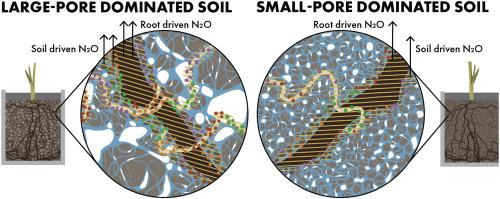Soil Biology and Biochemistry ( IF 9.8 ) Pub Date : 2022-01-29 , DOI: 10.1016/j.soilbio.2022.108565 Kyungmin Kim 1, 2 , Jenie Gil 2, 3 , Nathaniel E. Ostrom 2, 3 , Hasand Gandhi 2, 3 , Maxwell S. Oerther 1, 2 , Yakov Kuzyakov 4, 5 , Andrey K. Guber 1, 2 , Alexandra N. Kravchenko 1, 2

|
Root detritusphere is one of the most important sources of N2O, however, understanding of how N2O emission from the detritusphere is influenced by soil properties remains elusive. Here, we evaluated the effects of pore architecture and soil moisture on N2O emission during the decomposition of in-situ grown roots of switchgrass, an important bioenergy crop. We combined dual isotope labeling (15C and 15N) with zymography to gain insights into the location of the microbial N2O production in soils with contrasting pore architectures. In the studied soil, the effect of soil pore architecture on N2O emissions was 6 times greater than that of soil moisture. Soil dominated by > 30 μm Ø pores (i.e., large-pore soil) had higher chitinase activity than the soil dominated by < 10 μm Ø pores (i.e., small-pore soil), especially near the decomposing roots. The chitinase activity on the decomposing roots was positively correlated with emission of root-derived N2O, indicating that N released from root decomposition was an important source of N2O. Greater N2O and N2 emission was induced by switchgrass roots in soils dominated by the large- compared to the small-pore soils. The microenvironment developed near decomposing roots of the large-pore soil also resulted in positive N2O priming. Our study challenged the traditional view on soil moisture as the main factor of N2O production. Production and emission of N2O was most intensive in microbial activity hotspots (i.e., rhizosphere legacy) in the large pores, where decomposed roots release mineral N as the main N2O source.
中文翻译:

土壤孔隙结构和根际遗产定义了根碎屑层中 N2O 的产生
根碎屑层是 N 2 O的最重要来源之一,然而,了解碎屑层的 N 2 O 排放如何受土壤特性的影响仍然难以理解。在这里,我们评估了重要的生物能源作物柳枝稷原位生长根系分解过程中孔隙结构和土壤水分对 N 2 O 排放的影响。我们将双同位素标记(15 C 和15 N)与酶谱学相结合,以深入了解具有对比孔隙结构的土壤中微生物 N 2 O 产生的位置。在研究的土壤中,土壤孔隙结构对 N 2的影响O 排放量是土壤水分排放量的 6 倍。以> 30 μm Ø 孔隙为主的土壤(即大孔隙土壤)比以< 10 μm Ø 孔隙为主的土壤(即小孔隙土壤)具有更高的几丁质酶活性,尤其是在分解根附近。分解根的几丁质酶活性与根源性N 2 O的排放呈正相关,表明根分解释放的N是N 2 O的重要来源。与小孔隙土壤相比,以大孔隙土壤为主。大孔隙土壤腐烂根部附近形成的微环境也导致N 2为正O 启动。我们的研究挑战了将土壤水分作为 N 2 O 产生的主要因素的传统观点。N 2 O的产生和排放在大孔隙中的微生物活动热点(即根际遗留物)最为密集,其中分解的根释放矿物N 作为主要的N 2 O 来源。

































 京公网安备 11010802027423号
京公网安备 11010802027423号